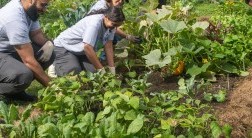The first step in conserving water is learning how much you use. According to the EPA’s WaterSense program, “an American family of four can use 400 gallons of water per day, and about 30 percent of that is devoted to outdoor uses.” Washing cars, maintaining swimming pools, and spraying down sidewalks and driveways account for a portion of that, but the sad truth is that a large percentage of outdoor water use goes to watering gardens and lawns. The EPA claims that half this water is wasted due to overwatering, improper irrigation, and evaporation.
Try an online calculator like the one at h2ouse.org, a website of the California Urban Water Conservation Council. Their water budget calculator takes the square footage of your turf, groundcover, and other plant life, along with some basic information from your water bill, and determines an ideal water budget for the outdoors.
By keeping a close eye on your local precipitation, you can allow rainfall to be your garden’s primary source of water (unless you live in an area of low annual rainfall or drought) and let the hose be a supplement. Rain gauges are available at many gardening supply stores, or you can even use an old can placed in an open area of your yard to keep track of your garden’s rainfall.
Seven Steps to Water Conservation
Xeriscaping, a water-saving form of gardening devised in the late 1970s and early ’80s, has now become an established practice, particularly in the dry West. Seven principles of xeriscaping, which can be applied to gardens everywhere, are as follows:
Planning and design
The design of your garden should take into consideration potential causes of water loss, like sloping terrain, windy spots, and runoff areas. Zone your plants according to their watering needs rather than, say, interspersing thirsty plants with succulents.Soil analysis and improvement
Healthy soil is essential to healthy plant life, and moreover, it conserves water. Add organic soil amendments, and when fertilizer is necessary, use slow-release types to prevent polluting runoff.Practical turf areas
Reduce the size of your lawn by adding a groundcover appropriate to your region or planting more shrubs. Plant native grass species; they are hardier and tend to require less supplemental water than non-native varieties. Set the mower so that only the top third of the grass blade is cut; it’ll force the roots of the grass to grow deeper.Appropriate plant selections
Another reason to “go native”: Species native to your area require less supplemental water, have fewer pest problems, and are generally more adaptable than imports. Avoid invasive species—even native ones—at all costs; they can greatly deplete water supplies for other plants.Efficient irrigation
Make sure that your sprinkler’s trajectory does not include fences or walkways that might deflect coverage or allow runoff. Better yet, eschew sprinklers entirely and use drip-irrigating hoses and watering cans, which allow watering at the base of the plant rather than over the foliage. To prevent evaporation, water in the morning (nighttime watering can cause fungal diseases in plants).Mulching
Mulch reduces evaporation, protects soil from erosion, and regulates soil temperatures—it’s essential to water-efficient gardens. Maintain a two- to three-inch layer of organic mulch in planting beds and containers.Regular maintenance
Weed regularly and remove dead, diseased, broken, or crowding branches from trees and shrubs—you’ll also be reducing your garden’s water needs.
If you want to take your water conservation a few steps further, install rainwater barrels—rainwater harvesting is easy and inexpensive. Maintain your plumbing; a leaky faucet can dribble away hundreds of gallons of water. In water conservation, little things add up.
Resources
Articles
“Gardening with Rainwater,” by Robin Simmen
“Water-Thrifty Gardening,” by Janet Marinelli
Websites
California Urban Water Conservation Council’s Garden Guide (plant lists for all of the country)
Water—Use It Wisely’s low-water-use plant list (divided by region of the country)
BBG’s drought-tolerant plant list



